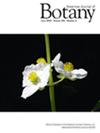When the sand blossoms: Phylogeny, trait evolution, and geography of speciation in Linanthus
Abstract
Premise
Understanding how plants successfully diversified in novel environments is a central question in evolutionary biology. Linanthus occurs in arid areas of western North America and exhibits extensive floral trait variation, multiple color polymorphisms, differences in blooming time, and variation in life history strategies. We reconstructed the evolutionary history of this genus.
Methods
We generated restriction-site associated (ddRAD) sequences for 180 individuals and target capture (TC) sequences for 63 individuals, with complete species sampling. Using maximum likelihood and pseudo-coalescent approaches, we inferred phylogenies of Linanthus and used them to model the evolution of phenotypic traits and investigate the genus's geographic speciation history.
Results
Relationships are consistent and well supported with both ddRAD and TC data. Most species are monophyletic despite extensive local sympatry and range overlap, suggesting strong isolating barriers. The non-monophyly of the night-blooming and perennial species may be due to rapid speciation or cryptic diversity. Perenniality likely evolved from annuality, a rare shift in angiosperms. Night-blooming evolved three times independently. Flower color polymorphism is an evolutionarily labile trait that is likely ancestral. No single geographic mode of speciation characterizes this diversification, but most species overlap in range, which suggests that they evolved in parapatry.
Conclusions
Our results illustrate the complexity of phylogenetic inference for recent radiations, even with multiple sources of genomic data and extensive sampling. This analysis provides a foundation for understanding aridity adaptations, such as evolution of flower color polymorphisms, night-blooming, and perenniality, as well as speciation mechanisms.


 求助内容:
求助内容: 应助结果提醒方式:
应助结果提醒方式:


